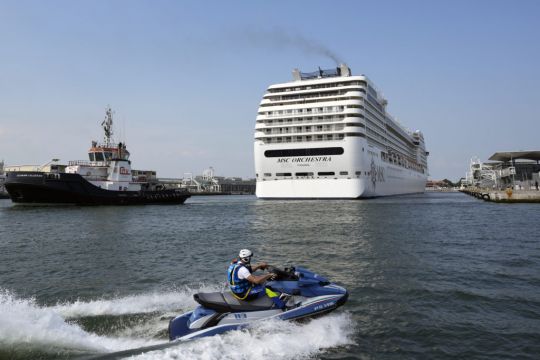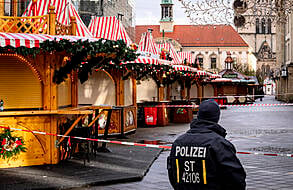The first cruise ship since the pandemic began has made its way through the heart of Venice, escorted by triumphant water-spouting tugboats and elated port workers.
However, hundreds of people staged protests on land and in a small armada of wooden boats waving “no big boats” flags as the cruise ship travelled down the Giudecca Canal.
The battle for Venice’s future was stark as the MSC Orchestra set sail with some 1,000 passengers.
The voyage heralded the return of cruise ships to the historic city of canals after more than 18 months, but the vessel reignited an anti-cruise movement that for more than a decade has opposed the passage of the enormous ships through the fragile lagoon due to environmental and safety concerns.

Italian premier Mario Draghi’s government pledged this spring to get cruise ships out of the Venice lagoon, but reaching that goal will take time.
Even an interim solution rerouting larger ships away from the Giudecca Canal is not likely before next year. Ridding the lagoon of the ships, which can be more than 250 metres in length and weigh over 90,000 tons, could take years.
Venice has become one of the world’s most important cruise destinations over the last two decades, and in 2019 served as a lucrative turnaround point for 667 cruise ships embarking nearly 700,000 passengers and carrying a total of 1.6 million, according to the association Cruise Lines International (Clia).
Passengers arriving on Saturday for the week-long cruise aboard the 16-deck MSC Orchestra, with stops in southern Italy, two Greek islands and Dubrovnik, Croatia, were greeted at the port with signs reading “welcome back cruises”.
Antonella Frigo, from nearby Vicenza, had her departure date delayed multiple times due to the pandemic and was excited to finally be leaving on holiday. But she also sympathised with activists who want the huge ships moved out of the centre of Venice.

“I have always said that they should be moved, but I’m sorry, I need to depart from Venice, since I am from nearby,’’ Ms Frigo said after being was dropped off at the cruise terminal. “But I hope they can be rerouted. I ask myself, ‘Is it not possible to come up with another solution, so they don’t pass where they shouldn’t?’.”
The message for passengers taking in Venice from the ship’s decks was mixed as the ship navigated the Giudecca Canal, past St Mark’s Square and the Doge’s Palace.
Hundreds of Venetians gathered at a noisy canal-side protest to demand an immediate halt to cruise ships moving through the lagoon, citing a series of past decrees they say were never enforced.
The MSC Orchestra responded with noisy blasts of its horn, while two dozen boats filled with port employees and VIPs motored alongside, celebrating the renewal of cruises and the return to work for hundreds of port workers.
According to the Venice Works Committee, more than 1,700 workers deal directly with cruise ships, from tugboat drivers to baggage carriers, while another 4,000 jobs depend on cruise traffic.
The long battle over cruise ships in Venice ramped up after the Costa Concordia cruise ship sank off Tuscany in 2012, killing 32 passengers and crew members. And it sharpened after the MSC Opera struck a dock and a tourist boat, injuring five people, while moving through the Giudecca Canal two years ago this week.

In all those years, no viable alternative has got off the drawing board.
The Venice Environmental Association, one of the groups against the ships, is demanding that Italian cultural and Venice port officials immediately ban ships from the lagoon, threatening legal action if there is no action within 15 days.
“It is a great provocation that a ship has passed,” said Andreina Zitelli, an environmental expert and member of the association. “You cannot compare the defence of the city with the defence of jobs in the interest of big cruise companies.”
The cruise industry’s trade association said it supports moving bigger ships to other areas to avoid traversing the Giudecca Canal but maintains that cruise ships still need access to Venice’s lagoon.
“We don’t want to be a corporate villain”’ said Francesco Galietti, of Cruise Lines International Italy. “We don’t feel we should be treated as such. We feel we are good to the communities.”
He said cruise ships account for only a small percentage of the tourism to Venice, somewhere around 5%, and that many passengers stay in the city before or after their cruises, contributing to the tourism-dependent economy.
In Rome, the Italian government said it is organising bids for a viable alternative outside the lagoon, and the request for proposals should be posted soon. Still, even an interim alternative route to the Giudecca Canal – moving larger ships to an industrial port west of Venice – will not be ready until next year.
Preparing the port of Marghera, which is still within the lagoon, requires lengthening existing piers to accommodate larger vessels as well as dredging a canal on the approach, cruise industry officials say. Under current plans, ships more than 250 metres, representing about 70% of cruise traffic, would be rerouted.







